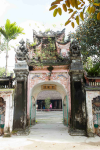
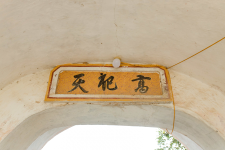
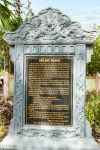
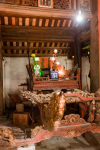
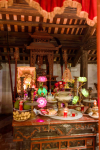
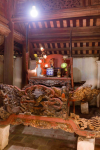
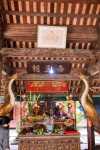
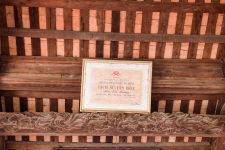
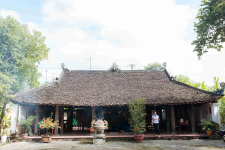
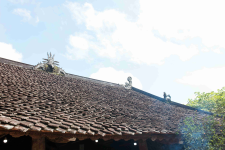
Camera tour
Price: Free
Time to visit a place: 120 phút
Open Time: 7:00 AM - Close Time: 6:00 PM
Address: Yen Son Village, Do Luong District, Nghe An Province
DUC HOANG TEMPLE – DO LUONG DISTRICT
Duc Hoang Temple was built in the early 16th century, on a flat and beautiful land, next to National Highway 7 in Yen Son commune, Do Luong district, Nghe An province, with a total area of 8,448m2 to worship King Le Trang Tong - the king who started the Middle Ages of the Later Le Dynasty and the gods.
At the end of the 16th century, the Hau Le dynasty was in decline and chaos, and the royal family had to hide their names. According to legend, King Quang Thieu's wife at that time was pregnant and ran back to her hometown in Diem Trang village, Anh Son distict to hide. Here she gave birth to a handsome son and an unusual appearance named Le Ninh. Growing up, Le Ninh was very smart and hardworking, soon knew how to work to support himself and his mother, defend the weak and guide people to reclaim land and establish villages.
The former subordinate of the Le Dynasty named An Thanh Hau Nguyen Kim started an army in Sam Nua, wanted to find the descendants of the Le royal family to worship as an ally, so he sent someone to find Le Ninh in Nghe An. When his subordinate found Le Ninh, he brought Le Ninh back to establish the Emperor's throne, set the era name as Nguyen Hoa, restored the Le Dynasty, he was 19 years old at that time. When he ascended to the throne, King Le Trang Tong knew how to respect talented people, listen to the right words, know how to comfort generals and reward them, so he encouraged soldiers and the people.
At that time, the country was in turmoil, King Le Trang Tong participated in fighting the enemy. Due to his hard work, he fell seriously ill and died on January 29, 1548. In memory of the King's merits for reviving the country, opening up and expanding a large area of land, giving the people a stable life, and having the merit of quelling the rebellion and making the people peaceful, the people built a temple for him. In addition to Le Trang Tong, Duc Hoang temple also worships 04 other people who were the maternal grandfather, paternal grandfather, father and mother of King Le Trang Tong.
In the past, Duc Hoang temple consisted of 3 halls with the layout of the letter "Tam" (three), gazebo three-way gate ... Through many ups and downs of history, the temple still retains the ancient beauty and location of the monument has not changed, basically retaining the components with sophisticated and unique carving art. Currently, Duc Hoang temple has only 3 works: gazebo three-way gate, worship house and back hall arranged along a vertical axis.
Three-way Gate is a work of majestic and ancient beauty with the connection between symbolic pillars, guard statues, stylized arches with many arches, many roofs...
The worship house is a 3-spaces, 2-act building consisting of 4 trusses of the quartet style. The front of the worship house is a system of "các cánh cửa hượng song hạ bản" (the upper part of the door is chiseled or barred, the bottom part is solid wood-plank) which are beautifully decorated. The middle space is carved with large Chinese characters and on two columns hiding in the front row with two dragon heads holding jade facing the altar. Inside the worship house, the rafters, trusses... are elaborately carved with a stylized rattan leaf motif and ancient pattern.
Back hall is a 3-spaces & 2-act house with mixed structure, beautifully carved wooden frame with traditional themes such as four sacred animals, four kinds of trees ... showing the talent and skillful hands of the ancient artisans. Each line is a complete 2-sided mini-work with vivid patterns and images such as carp turning into a dragon, unicorn, turtle, phoenix wading in a lotus pond...On the roof rafter, pillars, pedestals... are elaborately carved on both sides to create perfect works, standing in any space in the temple can also feel the beauty of wood carving art. The difference on 2 roof rafters of gable is each rafter having 2 more dragon heads with jade adoring towards the center.
Duc Hoang temple is a rare architectural and artistic relic in the system of architectural and artistic relics of Nghe An, not only in the architectural scale but also in the art of carving and decoration in the temple. Artifacts kept in the temple reflect the aesthetic and highly artistic features, 3 unique long Dinh palanquins have made the relic more valuable, elaborately carved gold-painted stencils with the theme of four sacred animals and four kinds of trees are represented by many very attractive and vivid motifs, besides there are many artifacts that are ancient sacrifices of value such as: dragon throne, dragon palanquin, eight precious objects....
From the Le dynasty, every year, people hold a ceremony to process the palanquin of King Le Trang Tong from Long Thai communal house (Thai Son commune) to Duc Hoang temple on the full moon day of January. This is the big festival of the People in Do Luong district. After the August Revolution, the procession was no longer held. Since 2013, the festival has been restored, organized solemnly and dignified, attracting a large number of people in the region as well as tourists from all over the country to sacrifice and enjoy with folk games such as tug of war, cockfight, card game...
In 1996, Duc Hoang temple was ranked by Ministry of Culture and Information (now known as Ministry of Culture, Sports and Tourism) as a national historical - architectural monument in Decision No. 51/QD-BVHTT.
Distance: 470 m
Distance: 620 m
Distance: 980 m
Distance: 1.07 km
Distance: 1.12 km
Distance: 1.46 km
Distance: 1.58 km
Distance: 1.66 km
Distance: 1.76 km
Distance: 2.24 km
Distance: 2.29 km
Distance: 4.51 km
Distance: 11.87 km
Distance: 13.75 km
Distance: 13.87 km
Distance: 13.99 km
Distance: 14.79 km
Distance: 15.22 km
Distance: 330 m
Distance: 650 m
Distance: 890 m
Distance: 1.03 km
Distance: 1.49 km
Distance: 1.60 km
Distance: 1.61 km
Distance: 1.72 km
Distance: 1.77 km
Distance: 1.77 km
Distance: 2.50 km
Distance: 13.60 km
Distance: 14.69 km
Distance: 14.86 km
Distance: 15.08 km
Distance: 15.24 km
Distance: 15.24 km
Distance: 15.68 km
Distance: 0 m
Distance: 0 m
Distance: 2.22 km
Distance: 2.79 km
Distance: 4.07 km
Distance: 5.88 km
Distance: 5.88 km
Distance: 6.33 km
Distance: 10.11 km
Distance: 10.38 km
Distance: 10.97 km
Distance: 12.64 km
Distance: 15.31 km
Distance: 15.38 km
Distance: 16.27 km
Distance: 16.40 km
Distance: 17.27 km
Distance: 9.74 km
Distance: 13.99 km
Distance: 15.34 km
Distance: 16.46 km
Distance: 17.83 km
Distance: 18.92 km
Distance: 18.92 km
Distance: 19.65 km
Distance: 19.83 km


